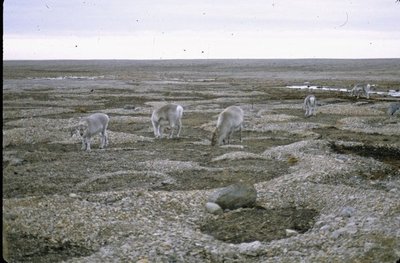March 18, 2008
Satellites can help Arctic grazers survive killer winter storms
Rain falling on snow sounds like a relatively harmless weather event, but when it happens in the far north it can mean lingering death for reindeer, musk oxen and other animals that normally graze on the Arctic tundra.
That was the case in October 2003 on Canada’s Banks Island, at the edge of the Beaufort Sea inside the Arctic Circle. Rain fell for several days on top of a 6-inch snow cover, and the rain seeped through the snow to the soil surface. The temperature then plunged and the water became a thick layer of ice that lasted the winter and prevented browsing animals from reaching their food supply of lichens and mosses at the soil’s surface. Some 20,000 musk oxen starved to death.
“Starvation happened over a period of many months and no one knew until they went up to do the population count the next spring,” said Thomas Grenfell, a University of Washington research professor of atmospheric sciences who has studied the Banks Island event.
Grenfell and Jaakko Putkonen, a UW research associate professor of Earth and space sciences, have found evidence of the 2003 rain-on-snow occurrence in passive satellite microwave imagery, which they believe could provide a signature to help detect such events anywhere. They detail their work in a paper to be published March 25 in Water Resources Research, a journal of the American Geophysical Union.
Their methods could provide native people, whose livelihood depends on hoofed animals such as musk oxen, reindeer and caribou with a realistic chance of getting food to the herds to prevent mass starvation.
“We are talking about Banks Island, but this applies to the whole Arctic – Alaska, northern Canada, Siberia, Scandinavia – wherever there is permafrost,” Putkonen said.
Grenfell has conducted more than 40 field experiments in polar regions and has become quite familiar with precipitation characteristics there. Much of the previous work he did was with researchers who were interested in the nature of the snowpack, but he found that the presence of water interfered with interpreting satellite microwave readings.
But for the new research, the signal from water was key. Grenfell and Putkonen looked for patterns in satellite microwave data that correlated with rain-on-snow events. They examined data from 10 different satellite microwave channels, each providing slightly different information on the condition of the snowpack.
“The subtleties in the microwave levels mean there can be high error margins on this information, but the Banks Island event stood out like a sore thumb in the data,” Grenfell said.
The researchers hope to examine other satellite microwave records in search of evidence of rain-on-snow events during the last 30 years that are known from anecdotal information.
The 2003 rain-on-snow event affected the northern part of the 43,000-square-mile Banks Island. The musk oxen population of 70,000 was cut by nearly 30 percent, but a caribou herd on the southern part of the island was unaffected. The closest weather station, about 60 miles from the musk oxen range, didn’t record any rainfall at the time of the event that resulted in the massive die off, so few people recognized that the oxen were in distress.
Currently there is no way to know exactly where or how often these potentially devastating rain-on-snow events occur, the researchers say, but using satellite data to locate them could make up for a scarcity of weather stations in the sparsely populated Arctic.
Rain-on-snow events historically have occurred mostly in coastal areas. However, in earlier research Putkonen found that models predict that climate change will push winter rainfall much farther into northern continents and large islands.
While food shortages can trigger a large die off, there also can be severe consequences from milder events that force animals to exert more energy to get food. That reduces body weight and limits reproduction, which in turn can cause long-term damage to herds.
“Because the Arctic stays well below freezing for eight to 10 months of the year, the ice layer can stay around for months. If a rain-on-snow event happens in the fall, these animals can go the whole winter without access to food,” Putkonen said. “The native people in the north depend on these animals for food and for many other things.”
###
For more information, contact Grenfell at (206) 543-9411, (206) 543-4576 or tcg@atmos.washington.edu; or Putkonen at (206) 543-0689 or putkonen@u.washington.edu.

